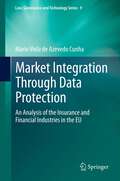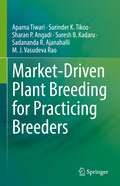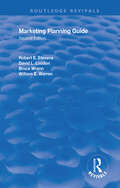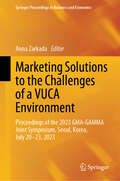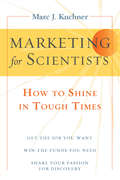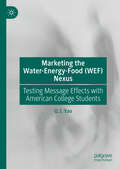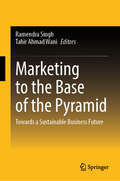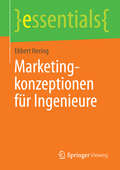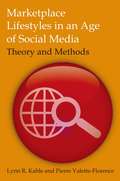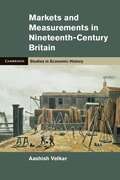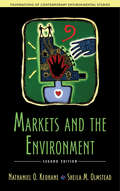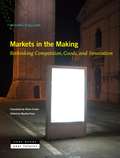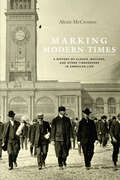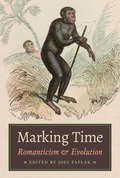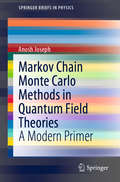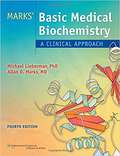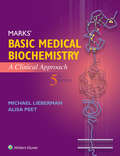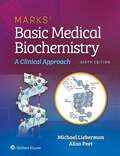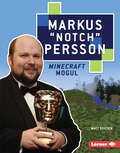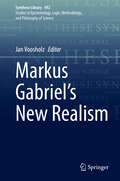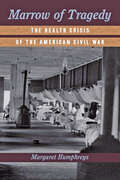- Table View
- List View
Market Integration Through Data Protection
by Mario Viola de Azevedo CunhaIn the context of the continuous advance of information technologies and biomedicine, and of the creation of economic blocs, this work analyzes the role that data protection plays in the integration of markets. It puts special emphasis on financial and insurance services. Further, it identifies the differences in the data protection systems of EU member states and examines the development of common standards and principles of data protection that could help build a data protection model for Mercosur. Divided into four parts, the book starts out with a discussion of the evolution of the right to privacy, focusing on the last few decades, and taking into account the development of new technologies. The second part discusses the interaction between data protection and specific industries that serve as case studies: insurance, banking and credit reporting. The focus of this part is on generalization and discrimination, adverse selection and the processing of sensitive and genetic data. The third part of the book presents an analysis of the legislation of three EU Member States (France, Italy and UK). Specific elements of analysis that are compared are the concepts of personal and anonymous data, data protection principles, the role of the data protection authorities, the role of the data protection officer, data subjects' rights, the processing of sensitive data, the processing of genetic data and the experience of the case studies in processing data. The book concludes with the proposal of a model for data protection that could be adopted by Mercosur, taking into account the different levels of data protection that exist in its member states.
Market-Driven Plant Breeding for Practicing Breeders
by Aparna Tiwari Surinder K. Tikoo Sharan P. Angadi Suresh B. Kadaru Sadananda R. Ajanahalli M. J. Vasudeva RaoThis book highlights the technicalities of plant breeding in a seed-business environment and explains the crucial aspects of the value chain. It educates the readers on how to initiate, participate, sustain national and international agreements for material transfer, how consortia work to facilitate germplasm accessibility, and how to set visionary goals to develop a superior plant varieties. The book covers the aspects such as how to conduct disease screening trials at hot spots, preparing an operational budget, and how to accelerate product advancement. Plant breeding is broadly defined as manipulation of plant genotypes to create phenotypes that are beneficial to mankind. It helps to achieve food security and sustainability by developing high yielding, climate-resilient, nutritious varieties of crops and hence is able to address unprecedented challenges like rising global population, diminishing genetic biodiversity, and uncertainties of the weather . This book is an extraordinary source of information starting from goal-genesis to market-oriented product-profiling and help readers to accelerate/enhance? their work/professional performance more effectively. This book will be very useful to practicing plant breeders at various levels in the public and private sectors. It is a must-have book for potential plant breeders who enter plant breeding profession just after the completion of their formal plant breeding education.
Marketing Intelligent Design
by Frank S. RavitchRecently a new battle has emerged between science and religion. The battle has focused on intelligent design (ID) and the numerous legal, philosophical, and educational concerns surrounding it. Resolution of these concerns centers on two questions: Is ID science? And is ID religion? Despite the fact that ID does not meet the standards of scientific rigor, ID proponents have been able to create a remarkably well-designed marketing plan aimed at imposing a theistic naturalism in schools and scientific discourse. Both the ID movement and some of its most vociferous opponents have a vested interest in suggesting that science, especially evolutionary biology, and religion are incompatible. This book presents a philosophical and legal counterpoint by demonstrating the compatibility between religion and evolutionary biology and the incompatibility between ID and mainstream science.
Marketing Planning Guide, Second Edition: A Guide To Developing A Strategic Marketing Plan
by Bruce Wrenn David L. Loudon Robert E. Stevens William E. WarrenThis newly revised book presents systematic approaches to developing marketing plans for products, services, and other situations. Philosophically sound and practically oriented, Marketing Planning Guide, Second Edition examines principles and their applications to provide a complete understanding of the marketing planning process. All aspects of marketing planning, including situation analysis, objectives, strategy, control, and implementation are thoroughly treated. Worksheets at the end of each chapter guide you in creating your own plan--once all the worksheets are completed you will have roughed out a complete marketing plan. Marketing Planning Guide, Second Edition is a valuable resource for the practitioner of marketing who is involved in the planning process and the student who is interested in learning more about what the marketing plan should contain and how to prepare it. This book shows you how to: analyze the market, consumers, the competition, and opportunitiesdevelop strategy and marketing objectivesmake product, place, promotional, and price decisionsrealize the financial impact of marketing strategiesimplement, audit, and control your marketing planChanges for this second edition include more tables, more (and newer) references, and updated case studies to open each chapter. The final chapter, “Marketing Plan Implementation,” is also all-new. The material in this book has been classroom-tested for both readability and comprehension, as well as usefulness in preparing a marketing plan as part of a course assignment.The accompanying instructor&’s package to Marketing Planning Guide includes a helpful150-page instructor&’s manual and over 175 slide transparencies. The manual provides a detailed sample course syllabus along with a test bank featuring a muliple-choice or true-false test for each chapter, along with an answer key. The transparencies are prepared to reinforce the key points of each chapter and includes many charts, figures, and lists. This helpful instructor&’s pack will save you time and will help make your course effective and thorough.
Marketing Solutions to the Challenges of a VUCA Environment: Proceedings of the 2023 GMA-GAMMA Joint Symposium, Seoul, Korea, July 20-23, 2023 (Springer Proceedings in Business and Economics)
by Anna ZarkadaThis book contains selected papers from the 2023 Greek Marketing Academy and the Global Alliance of Marketing and Management Associations Joint Symposium (GMA-GAMMA2023) held from July 20 to 23, 2023, in Seoul, Korea. It presents cutting-edge research in the marketing field, showcases how the recent challenges have affected marketing management and/or marketing communications and introduces the solutions to the practical problems under the Volatile, Uncertain, Complex and Ambiguous (VUCA) environment.
Marketing for Scientists: How to Shine in Tough Times
by Marc J. KuchnerIt's a tough time to be a scientist: universities are shuttering science departments, federal funding agencies are facing flat budgets, and many newspapers have dropped their science sections altogether. But according to Marc Kuchner, this antiscience climate doesn't have to equal a career death knell-it just means scientists have to be savvier about promoting their work and themselves. In Marketing for Scientists, he provides clear, detailed advice about how to land a good job, win funding, and shape the public debate. As an astrophysicist at NASA, Kuchner knows that "marketing" can seem like a superficial distraction, whether your daily work is searching for new planets or seeking a cure for cancer. In fact, he argues, it's a critical component of the modern scientific endeavor, not only advancing personal careers but also society's knowledge. Kuchner approaches marketing as a science in itself. He translates theories about human interaction and sense of self into methods for building relationships-one of the most critical skills in any profession. And he explains how to brand yourself effectively-how to get articles published, give compelling presentations, use social media like Facebook and Twitter, and impress potential employers and funders. Like any good scientist, Kuchner bases his conclusions on years of study and experimentation. In Marketing for Scientists, he distills the strategies needed to keep pace in a Web 2.0 world.
Marketing the Water-Energy-Food (WEF) Nexus: Testing Message Effects with American College Students
by Q.J. YaoThis book helps readers understand the persuasiveness of popular message levels (agenda, knowledge, attitude, and behavioral intention) and factors (sidedness, conclusiveness, and gain- or loss-framing) in communicating critical environmental issues, particularly the Water-Energy-Food (WEF) Nexus. The WEF Nexus is a relatively new environmental concept that has been deemed by leading scientists and international organizations as an effective solution to water, energy, and food shortages and crises. It is vital to garner sufficient public support for the concept to function. This book addresses questions such as: How can we strategically and effectively communicate the WEF Nexus to the public to raise necessary public awareness and supportive attitudes, avoid unnecessary politicization, and secure public resources to cope with the water, energy, and food issues before they drastically deteriorate? How can some commonly used message factors affect the persuasiveness of the WEF-nexus strategic communications, and how may those communications be processed by the audience? These questions are answered with data from the National College Student Science Literacy Survey (NCSSLS), a relatively representative survey of American college students in 2016-2018, with a survey experiment included in its second round.
Marketing to the Base of the Pyramid: Towards a Sustainable Business Future
by Ramendra Singh Tahir Ahmad WaniThis book is a collection of nine chapters discussing the impact of sustainable marketing and business practices on the stakeholders at the base of the pyramid (BoP). It explores multifaceted dimensions related to sustainable practices such as sustainable consumer behavior, marketplace literacy for low-income and low-literate consumers, innovation and BoP and emerging markets, bridging vulnerability and sustainability, inclusive marketing practices, and how to bridge the economic, social and environmental aspects of sustainability. These chapters have been authored by the best marketing scholars working in the domain of marketing at the base of the pyramid, including scholars who actively promote bottoms up approach to enhance well-being and prosperity of subsistence marketplaces. Primarily aimed at marketing scholars, another important objective of this edited book is to reach out to organizations looking for deeper insights on how they can successfully position their products and services to poor consumers, or even how they can purchase/source products and services from poor producers. Professional associations such as ASSOCHAM, CII, FICCI, AIMA, AMA would also find many relevant takeaways in the book, as would academicians and policymakers of developing nations in Asia, Americas and Africa.
Marketingkonzeptionen für Ingenieure (essentials)
by Ekbert HeringMarketing ist nach modernem Verständnis die Führung eines Unternehmens vom Markt her. Erfolgreich wird ein Unternehmen nur sein, wenn es seine Produkte und Dienstleistungen so bereitstellt, dass sie den Bedürfnissen des Marktes entsprechen und somit aktuelle Kundenwünsche befriedigen. Für eine erfolgreiche Marketingkonzeption ist folgendes entscheidend: Trends zu erkennen, Kundengruppen zu selektieren und deren Bedürfnisse relativ zum Wettbewerber besser zu befriedigen sowie dies den betreffenden Kunden zu kommunizieren. Die daraus abgeleitete Systematik wird durch den Marketingmix beschrieben, der durch die neun P: Produkt-Mix (product), Preis-Mix (price), Distributions-Mix (Place), Kommunikations-Mix (Promotion), Kontrahierungs-Mix (Precise contract), Mitarbeiter-Mix (People), Prozesse, Gebäude und Anlagen (Physical Facilities) sowie Kooperations-Mix (Partnership) gekennzeichnet ist. Marketing-Controlling ermöglicht es, die gesetzten Ziele zeitnah zu erfassen, die Zieleinhaltung festzustellen und entsprechende Korrekturen vorzunehmen.
Marketplace Lifestyles in an Age of Social Media: Theory And Methods
by Lynn R Kahle Pierre Valette-FlorenceThis book approaches the concept of lifestyle from a contemporary scholarly perspective, and subjects it to rigorous theoretical and conceptual standards from an integrated, applied psychological point of view. Marketplace Lifestyles in an Age of Social Media is exceptionally current, demonstrating how recent trends and developments in social media reflect the importance of lifestyle research in marketing. Numerous examples, illustrations, and comprehensive references are provided, making this volume the best single resource for scholars, students, and marketing experts in this important area of marketing theory and practice.
Markets and Measurements in Nineteenth-Century Britain
by Aashish VelkarMeasurements are a central institutional component of markets and economic exchange. By the nineteenth century, the measurement system in Britain was desperately in need of revision: a multiplicity of measurement standards, proliferation of local or regional weights and measures, and a confusing array of measurement practices made everyday measurements unreliable. Aashish Velkar uncovers how metrology and economic logic alone failed to make 'measurements' reliable, and discusses the importance of localised practices in shaping trust in them. Markets and Measurements in Nineteenth-Century Britain steers away from the traditional explanations of measurement reliability based on the standardisation and centralisation of metrology; the focus is on changing measurement practices in local economic contexts. Detailed case studies from the industrial revolution suggest that such practices were path-dependent and 'anthropocentric'. Therefore, whilst standardised metrology may have improved precision, it was localised practices that determined the reliability and trustworthiness of measurements in economic contexts.
Markets and the Environment, Second Edition (Foundations Contemporary Environmental)
by Dr Sheila M. Olmstead Mr Nathaniel O. KeohaneA clear grasp of economics is essential to understanding why environmental problems arise and how we can address them. So it is with good reason that Markets and the Environment has become a classic text in environmental studies since its first publication in 2007. Now thoroughly revised with updated information on current environmental policy and real-world examples of market-based instruments, the primer is more relevant than ever.The authors provide a concise yet thorough introduction to the economic theory of environmental policy and natural resource management. They begin with an overview of environmental economics before exploring topics including cost-benefit analysis, market failures and successes, and economic growth and sustainability.Readers of the first edition will notice new analysis of cost estimation as well as specific market instruments, including municipal water pricing and waste disposal. Particular attention is paid to behavioral economics and cap-and-trade programs for carbon.Throughout, Markets and the Environment is written in an accessible, student-friendly style. It includes study questions for each chapter, as well as clear figures and relatable text boxes. The authors have long understood the need for a book to bridge the gap between short articles on environmental economics and tomes filled with complex algebra. Markets and the Environment makes clear how economics influences policy, the world around us, and our own lives.
Markets in the Making: Rethinking Competition, Goods, and Innovation (Near Future Series)
by Michel CallonSlicing through blunt theories of supply and demand, Callon presents a rigorously researched but counterintuitive model of how everyday market activity gets produced.If you’re convinced you know what a market is, think again. In his long-awaited study, French sociologist and engineer Michel Callon takes us to the heart of markets, to the unsung processes that allow innovations to become robust products and services. Markets in the Making begins with the observation that stable commercial transactions are more enigmatic, more elusive, and more involved than previously described by economic theory. Slicing through blunt theories of supply and demand, Callon presents a rigorously researched but counterintuitive model of market activity that emphasizes what people designing products or launching startups soon discover—the inherent difficulties of connecting individuals to things. Callon’s model is founded upon the notion of “singularization,” the premise that goods and services must adapt and be adapted to the local milieu of every individual whose life they enter. Person by person, thing by thing, Callon demonstrates that for ordinary economic transactions to emerge en masse, singular connections must be made.Pushing us to see markets as more than abstract interfaces where pools of anonymous buyers and sellers meet, Callon draws our attention to the exhaustively creative practices that market professionals continuously devise to entangle people and things. Markets in the Making exemplifies how prototypes, fragile curiosities that have only just been imagined, are gradually honed into predictable objects and practices. Once these are active enough to create a desired effect, yet passive enough to be transferred from one place to another without disruption, they will have successfully achieved the status of “goods” or “services.” The output of this more ample process of innovation, as redefined by Callon, is what we recognize as “the market”—commercial activity, at scale.The capstone of an influential research career at the forefront of science and technology studies, Markets in the Making coherently integrates the empirical perspective of product engineering with the values of the social sciences. After masterfully redescribing how markets are made, Callon culminates with a strong empirical argument for why markets can and should be harnessed to enact social change. His is a theory of markets that serves social critique.
Marking Modern Times: A History of Clocks, Watches, and Other Timekeepers in American Life
by Alexis MccrossenThe public spaces and buildings of the United States are home to many thousands of timepiecesOCobells, time balls, and clock facesOCothat tower over urban streets, peek out from lobbies, and gleam in store windows. And in the streets and squares beneath them, men, women, and children wear wristwatches of all kinds. Americans have decorated their homes with clocks and included them in their poetry, sermons, stories, and songs. And as political instruments, social tools, and cultural symbols, these personal and public timekeepers have enjoyed a broad currency in art, life, and culture. In "Marking Modern Times," Alexis McCrossen relates how the American preoccupation with time led people from across social classes to acquire watches and clocks. While noting the difficulties in regulating and synchronizing so many timepieces, McCrossen expands our understanding of the development of modern time discipline, delving into the ways we have standardized time and describing how timekeepers have served as political, social, and cultural tools in a society that doesnOCOt merely value time, but regards access to time as a natural-born right, a privilege of being an American. "
Marking Time: Romanticism and Evolution
by Joel FaflakScholars have long studied the impact of Charles Darwin’s writings on nineteenth-century culture. However, few have ventured to examine the precursors to the ideas of Darwin and others in the Romantic period. Marking Time, edited by Joel Faflak, analyses prevailing notions of evolution by tracing its origins to the literary, scientific, and philosophical discourses of the long nineteenth century. The volume’s contributors revisit key developments in the history of evolution prior to The Origin of Species and explore British and European Romanticism’s negotiation between the classic idea of a great immutable chain of being and modern notions of historical change. Marking Time reveals how Romantic and post-Romantic configurations of historical, socio-cultural, scientific, and philosophical transformation continue to exert a profound influence on critical and cultural thought.
Markov Chain Monte Carlo Methods in Quantum Field Theories: A Modern Primer (SpringerBriefs in Physics)
by Anosh JosephThis primer is a comprehensive collection of analytical and numerical techniques that can be used to extract the non-perturbative physics of quantum field theories. The intriguing connection between Euclidean Quantum Field Theories (QFTs) and statistical mechanics can be used to apply Markov Chain Monte Carlo (MCMC) methods to investigate strongly coupled QFTs. The overwhelming amount of reliable results coming from the field of lattice quantum chromodynamics stands out as an excellent example of MCMC methods in QFTs in action. MCMC methods have revealed the non-perturbative phase structures, symmetry breaking, and bound states of particles in QFTs. The applications also resulted in new outcomes due to cross-fertilization with research areas such as AdS/CFT correspondence in string theory and condensed matter physics. The book is aimed at advanced undergraduate students and graduate students in physics and applied mathematics, and researchers in MCMC simulations and QFTs. At the end of this book the reader will be able to apply the techniques learned to produce more independent and novel research in the field.
Marks' Basic Medical Biochemistry (Fourth Edition): A Clinical Approach
by Michael A. Lieberman Alisa Peet Allan MarksMarks’ Basic Medical Biochemistry takes a patient-oriented approach that links biochemistry to physiology and pathophysiology, allowing students to apply fundamental concepts to the practice of medicine—from diagnosing patients to recommending effective treatments. Intuitively organized chapters center on hypothetical patient vignettes and helpful icons allow for smooth navigation, making complex concepts easier to grasp!
Marks' Basic Medical Biochemistry: A Clinical Approach
by Alisa Peet Michael LiebermanConnect biochemistry to clinical practice! Marks’ Basic Medical Biochemistry links biochemistry to physiology and pathophysiology, allowing students to apply fundamental concepts to the practice of medicine – from diagnosing patients to recommending effective treatments.
Marks' Basic Medical Biochemistry: A Clinical Approach
by Michael A. Lieberman Alisa PeetMarks’ Basic Medical Biochemistry: A Clinical Approach, 6th Edition links biochemistry to physiology and pathophysiology, empowering students to confidently apply fundamental concepts to the practice of medicine — from diagnosing patients to recommending effective treatments. This proven, application-centered approach builds biochemical coverage around related clinical concepts to anchor students’ understanding to a clinical context from day one. Intuitively organized chapters center on hypothetical patient vignettes to emphasize clinical applications, and helpful icons, images, and review questions make complex concepts easier to grasp.
Markus "Notch" Persson: Minecraft Mogul (Gateway Biographies Ser.)
by Matt DoedenMinecraft creator Markus "Notch" Persson has always loved programming. Find out how he translated his childhood passion for writing code into a multi-million dollar career as the mind behind Minecraft!
Markus Gabriel’s New Realism (Synthese Library #492)
by Jan VoosholzThis is the first volume focused on Markus Gabriel’s version of New Realism, which spans the fields of metaphysics/ontology, philosophy of mind, epistemology, philosophy of science, and meta-philosophy. Most of the selected contributions are directly or indirectly concerned with Gabriel’s fields of sense-ontology, his version of a thoroughly realistic pluralism. While some take up criticisms from previous debates surrounding Gabriel’s philosophy and New Realism in general, others advance completely new and innovative challenges for this highly systematic thinker. Overall, the contributions provide both a substantive commentary on Gabriel’s work and a multifaceted, critical assessment of its underlying ideas. The book is not only an essential addition to the debate surrounding New Realism, but also furthers the discussions about naturalism, deflationist ontologies, contextualism and mereological arguments to which Gabriel’s work has contributed in recent years.
Marrow of Tragedy: The Health Crisis of the American Civil War
by Margaret HumphreysSoldiers lay wounded or sick as both sides struggled to get them fit to return to battle.Winner, George Rosen Prize, American Association for the History of MedicineThe Civil War was the greatest health disaster the United States has ever experienced, killing more than a million Americans and leaving many others invalided or grieving. Poorly prepared to care for wounded and sick soldiers as the war began, Union and Confederate governments scrambled to provide doctoring and nursing, supplies, and shelter for those felled by warfare or disease. During the war soldiers suffered from measles, dysentery, and pneumonia and needed both preventive and curative food and medicine. Family members—especially women—and governments mounted organized support efforts, while army doctors learned to standardize medical thought and practice. Resources in the north helped return soldiers to battle, while Confederate soldiers suffered hunger and other privations and healed more slowly, when they healed at all.In telling the stories of soldiers, families, physicians, nurses, and administrators, historian Margaret Humphreys concludes that medical science was not as limited at the beginning of the war as has been portrayed. Medicine and public health clearly advanced during the war—and continued to do so after military hostilities ceased.
Mars
by Mary Kay CarsonIf you looked up into the night sky, you might see a glowing object that is brighter and redder than most of the stars. This is Mars. <P><P> Are you ready for a close-up view of this mysterious red planet? Find out about a spacecraft that have traveled to Mars, and about plans to send people there in the near future.
Mars
by Tim GossFrom its place in the night sky to its external and interior features, the mysteries of a specific astral body are uncovered in each title. Readers will learn how it was discovered, where it got its name, and how it compares in size to Earth and different bodies in space. Each title is filled with stunning color photos from NASA.
Mars (Planet Guides)
by Duncan BrewerDid you know that people thought for the longest time that Mars was inhabited by a advanced race who used canals to help conserve water? Or that Mars is named after the Roman God of war. That Mars has two moons, and that Mars, is the closest to Earth in Make up. Learn about the "Red Planet" in this fact filled book [which is] great for research or as an introduction to the Solar system.
